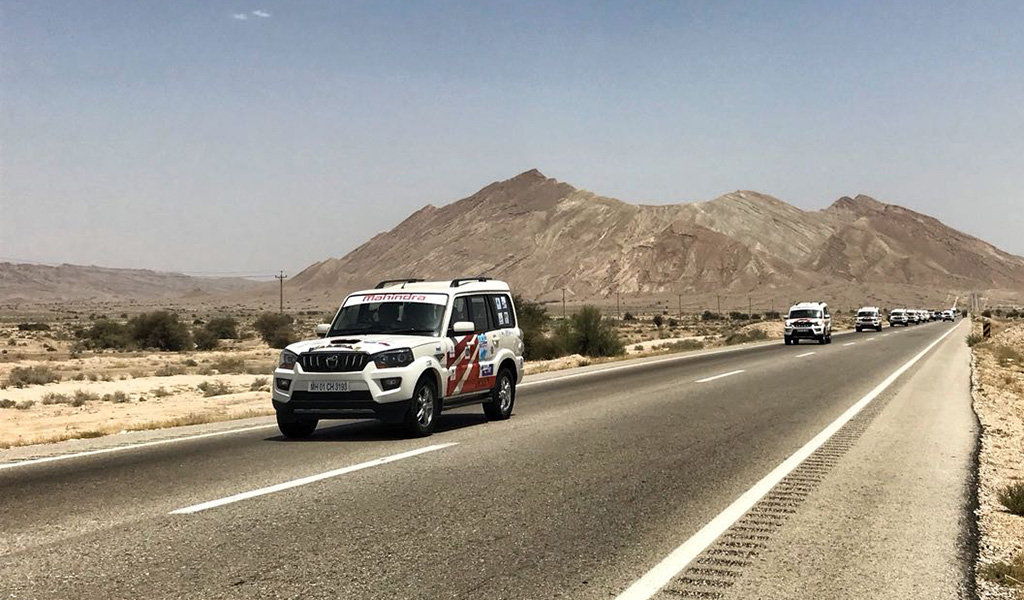Discovering Iran’s excellent road network on the INSTC Friendship rally

Breezing through Iran on INSTC
Iran has an excellent road network, and all across the vast country. We started the INSTC Friendship Rally from the southern port of Bandar Abbas, not only Iran’s largest port in Iran but the entire region handling the largest volume of goods. Because Bandar Abbas is so packed, India is helping develop (and operate) Chabahar port that is actually very close to Bandar Abbas as the crow flies and will also be connected on the International North South Transport Corridor. The port will be operational when the INSTC Friendship Rally returns to Iran after hitting the Baltic seaport of Saint Petersburg.
Infrastructure is a crucial part of the trade corridor – this includes not just roads but a parallel rail network that feeds into and off of the sea routes. We are interested in the road network and Iran’s is excellent. Bandar Abbas to Shiraz is a mix of dual carriageway and single lane roads but even the latter has very little traffic and is possible to average an easy 90kmph. Further up from Shiraz the roads are all dual carriageways, very well marked out, very well organised with interchanges that are very well engineered… it’s all way, way superior to the road network we have in India.
The INSTC route from Isfahan to Tehran
Isfahan to Tehran is a busy route, sort of like Pune to Mumbai or Jaipur to Delhi, and the volume of traffic goes up dramatically from our earlier days on the road in Iran. To account for it there’s an expressway connecting the two cities, which is a fabulous road prompting the question from all of us on the drive, “why can’t India build proper roads?”
“Where are the trucks? One theory is the rail network is so good it reduces the dependence on trucks”
With the volume of traffic going up as we drive to the North of Iran so does the number of speed cameras and also cops cars – the latter parked on a raised platform on the side of the road ready to deploy. The speed limit is 120kmph though and with traffic moving quickly averaging 110kmph is an absolute breeze, hit the cruise control on our Mahindra’s and keep chugging along.
But where are the trucks?
Driving to Tehran I don’t see any trucks. Just a smattering, but for an expressway connecting two important cities there’s no truck traffic. Where are the trucks? One theory is the rail network is so good it reduces the dependence on trucks. The other is there’s a separate truck route from Bandar Abbas. I cannot research it because Google is blocked in Iran so will read up on it when we get back home. But the lack of trucks is surprising and also a contributor to the smooth, quick flow of traffic.
Roads in the Iranian capital of Tehran
Tehran has a population of 8.2 million, 11 million when you account for the Tehran metropolitan region. That’s over 10 per cent of the country’s population of 85 million. No surprise that as we get to Tehran on the INSTC Friendship Rally all four lanes of the expressway are filled with cars, all doing at least 100 clicks. The volume keeps going up as we enter Tehran, a city I’m told has horrible traffic. But truth be told it’s nothing we Indians cannot handle. Delhi, Mumbai, Bangalore, all have worse traffic, made worse by India’s zero traffic discipline. In Tehran the lanes are clearly marked out, well signposted, and free from bottlenecks. Our hotel is on the other end of Tehran and we do not encounter a single traffic signal until our hotel turn off. I’ve not driven in any other city where I’ve experienced this! Later on I notice that the roads are elevated over all junctions and the space underneath is used for gardens and paintings. It’s excellent.
In Tehran you do find crazy drivers gunning their cars and cutting lanes
We took a cab ride back from the Indian Embassy and I was on the edge of my seat for the most part. But what I notice is that traffic moves at a fair clip. And again no traffic lights! Also all the signboards are in English. For a country that barely speaks any English all the signboards are in English, and all over the country not just in Tehran. It’s a good thing because visitors will have to navigate through Iran the old fashioned way looking at signboards because even though Google Maps has mapped out Iran there is no turn-by-turn navigation and the refresh rate is slow.
“For a country that barely speaks any English all the signboards are in English”
And finally a note on the Iranian driving – disciplined, courteous and a generally high standard of driving. We encountered one traffic jam on a single carriageway and nobody jumped the solid white line to go to the head of the queue. They also seem like a very happy lot. Almost everybody who passed our convoy smiled and waved at us. Iran is a great country, absolutely nothing like what our (Western-media-shaped) worldview is.


